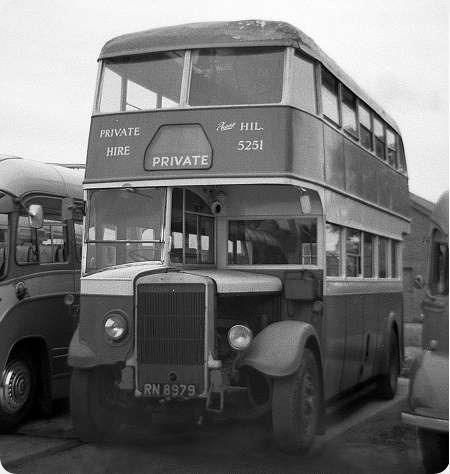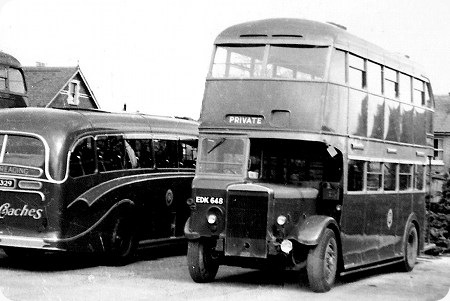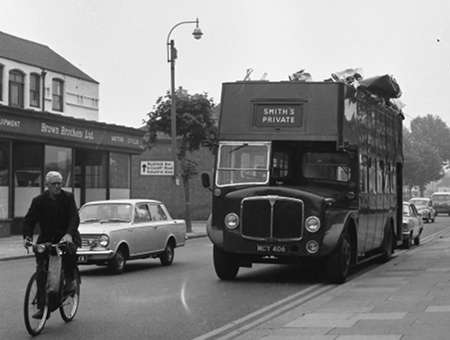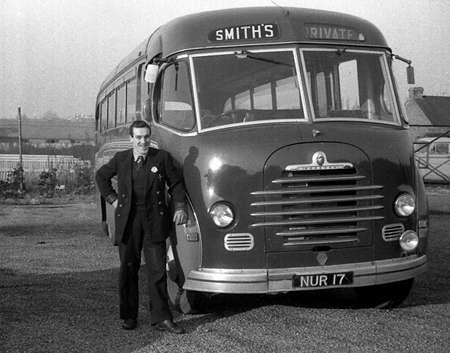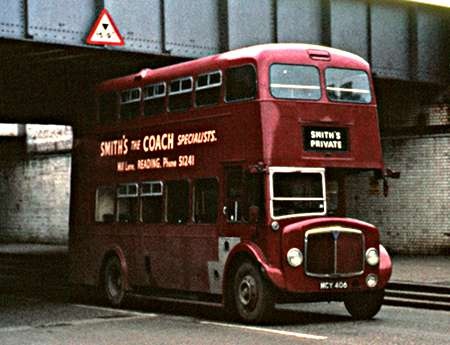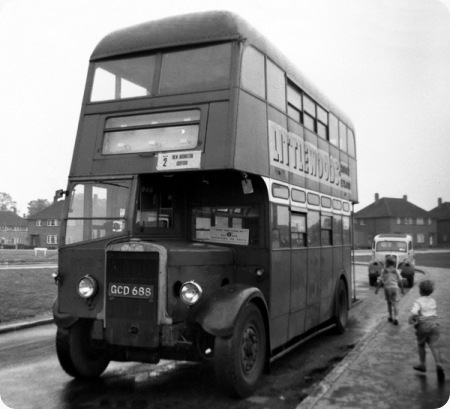Ribble - Leyland Titan TD7 - RN 8979 - 2323
Ribble Motor Services
1940
Leyland Titan TD7
Leyland L27/26R
I cannot now remember where in 1960 I took this rather sad picture of
RN 8979, a former Ribble
Leyland TD7 with Leyland L27/26R bodywork, or who the operator then was. The old telephone code HIL (for
Hillside) covered the Barnt Green area of Birmingham, which might help to identify the operator.
Confirmed Leyland aficionado Ribble must have counted itself lucky to obtain a batch of forty TD7s in
May 1940 just after the German attack in France had brought the Phoney War to a violent end.
Photograph and Copy contributed by Roger Cox
12/11/18 - 07:57
I believe they were actually Alexander bodies, Roger, sub contracted and built
to Leyland design, as the latter were at that time overwhelmed by work.
I think Samelsbury
Engineering also built a few bodies to Leyland design and possibly parts, for the same reason.
Mr Anon
12/11/18 - 07:58
This is recorded by the P.S.V. Circle as being withdrawn by Ribble in 1956 and
passing to:-
Smith, Reading 12/56
Liss & District, Bordon 10/58
Trebilock
(Finchley Coaches), London N.12 10/59
Dickson, Stoke Mandeville 1/61
last licenced
4/61 and to Ronsway, Hemel Hempstead in 1961, for scrap
I have just checked the old London telephone exchange names and HILlside covered North Finchley tying in nicely with the Trebilcock dates.
John Kaye
12/11/18 - 08:00
I notice that every one of the near side upper deck windows within the five bays has a half drop ventilator fitted. It appears, from photographs of similar Ribble buses I’ve looked at, that the corresponding windows on the off side had no ventilators fitted at all. It seems rather an unusual arrangement, was this Ribble’s normal specification for lowbridge vehicles?
Chris Barker
12/11/18 - 16:07
The nearside half drop would be accessible from the seats, whilst the offside would only be accessible from the sunken aisle so the positioning of the opening windows makes sense.
Phil Blinkhorn
12/11/18 - 16:08
Wow I thought these Blackburn Corporation buses had been scraped. Glad to know
they are now vintage buses. My school was on the East Park side of Blackburn and I rode on these to
and from school.
They were ancient and noisy to travel in. I enjoyed my journeys. It started
a life long interest in buses and travelling on them.
For me these buses bring back my
childhood memories of living in Blackburn.
Wonderful bus journeys.
William Ferguson
12/11/18 - 16:10
Thanks, everyone, for the extra information. The Ribble fleet number for this
bus was 2323. Alexander did build ‘identikit’ bodies for Leyland, but, in his book on the TD
series Titan in the series "The Best of British Buses", Alan Townsin says that these were
Leyland bodies, rather than Alexander built clones. Confirmation one way or the other would be
welcome.
John, your comprehensive history of this vehicle does confirm that it must have
belonged to Finchley Coaches when photographed, which reassures me considerably in my advancing
years - I cannot recall ever visiting the Birmingham area in the early 1960s. I am surprised that
the less than pristine state of the bus as depicted in the photo still enabled it to work for a
further year or so. Chris, I think that a half drop ventilator on the upper deck offside can just be
detected through the front upper deck window. It is to the credit of the integrity of the Leyland
body design that, after a life of some twenty years. there is no hint of any sag in the waist
rail.
Roger Cox
12/11/18 - 16:11
Mr. Anon, There is no record of these on the Alexander records. I think you are confusing things with the early post-war situation which was discussed a year ago on the SCT61 site, and the chassis involved were Leyland PD1 and PD1A types in 1946/7.
John Kaye
13/11/18 - 05:35
Regarding location I think this was at the Austin works at Longbridge. Many of these buses collected workers from the Midlands and were driven by an operative also PSV qualified.
Nigel Edwards
14/11/18 - 07:11
Just a thought re Roger Cox’s possible view of offside half drop windows and the gangway, Is the visible line not more likely to be a handrail fixed to the window pillars?
Stan Zapiec
14/11/18 - 07:12
John: I always thought that Leyland did not, in principle, rebody older chassis. The only exception to that rule being the examples they rebodied for Plymouth Corporation. But, I must be incorrect in that assumption.
Mr Anon
15/11/18 - 07:40
Mr. Anon, I don’t follow your comment on Leyland not in principle rebodying vehicles, in relation to the Ribble vehicle. RN 8979 was new in 1940 with a 1940 Leyland body and so rebodying does not come into the equation.
John Kaye
16/11/18 - 06:59
One might similarly not follow the comment about Blackburn Corporation, but I suppose that, from a passenger’s perspective, there wouldn’t be such a great difference between the above and Blackburn’s PD1s/PD1As, of which Blackburn had rather a lot.
David Call
17/11/18 - 07:42
…although a PD1 and a TD7 would sound rather different in the definitive second and third gear music.
Stephen Ford
17/11/18 - 07:45
Yes John, that is my mistake, at first glance the bus looks like one of
Ribble’s pre war Leyland TDs, rebodied after WW2. Some were also rebodied by ECW. But on closer
inspection the body fitted to RN8979 is the original 1940 Leyland body. The height of the driver’s
door side window, visible through the windscreen, is a give away.
I still maintain that
Leyland did not in principle rebody existing chassis, even of their own manufacture, except for the
two pre war Titans rebodied with Farrington type bodies for Plymoth. I believe Donald Stoke’s father
was GM at Plymouth at the time, which may have influenced their deciscion.
Mr Anon
20/11/18 - 15:09
Ledgards bought two of the early metal framed Leyland bodies in 1934. These caused no end of trouble and Sam being Sam prevailed upon Leyland to rebody them in 1938.
Chris Hough
22/12/18 - 12:21
Chris, Sam was not the only disgruntled operator to trouble Mr Spurrier’s door. On one day he received a delegation, Messrs Sword, Dick and Alexander..
Stephen Allcroft
09/04/21 - 06:36
Further to Mr Anon (17/11/18), a total of eight Plymouth Leyland TD5c, originally Weymann-bodied, were rebodied postwar by Leyland. Two were the last of the 1938 batch (213/4: ADR 813/4), of which 213 became 141 after rebodying. The other six were presumably from the 1939 batch (215-39: BDR 252-76), but there is no acknowledgement on BLOTW of this. 232 (BDR 269) became 143 after rebodying. 213 and 232 later served with Theobald’s of Long Melford.
David Frank
Quick links to the - Comments Page - Contact Page - Home Page
